Worker Dies As a Result of Being Struck and Pinned Between Two Vehicles While Repairing Potholes
Michigan Case Report: 03MI005
Summary
On Monday, January 13, 2003, at approximately 11:40 a.m., a 40-year old male worker repairing a road with cold patch was momentarily pinned between the cold patch truck he was shoveling cold patch from (Figure 1) and the backup vehicle pulling the flasher board warning arrow signaling drivers to stay back from the work crew (Figure 2). He collapsed and died on January 15, 2003, at the hospital where he had been taken after his injury as he was preparing to leave the hospital.
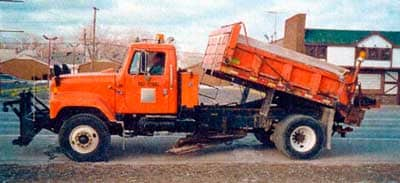
|
|
Figure 1. Cold Patch Truck
|
Recommendations:
- The employer should develop and provide periodic training that ensures that employees recognize the hazards associated with their work and the consequences of becoming complacent regarding those hazards.
- The employer should install after market devices (i.e., camera, radar, and sonar) on construction vehicles and equipment to help monitor the presence of workers on foot in blind areas.
- Employers should ensure that safe work procedures are in place for the use of mobile construction vehicles, a spotter is designated to direct movement of these vehicles, and drivers are in communication with workers on foot.
Introduction
On Monday, January 13, 2003, at approximately 11:40 a.m., a 40-year-old worker repairing a road with cold patch was momentarily pinned between the cold patch truck and the backup vehicle pulling the flasher board with the warning arrow. He collapsed and died on January 15, 2003, at the hospital where he had been taken after his injury as he was preparing to leave the hospital. On January 16, 2003, MIFACE investigators were informed of the fatality by the Michigan Occupational Safety and Health Act (MIOSHA) personnel who had received notification of the death on their 24 hour-a-day hotline. On May 3, 2006, the MIFACE researcher interviewed the safety manager of the county for whom the decedent worked. During the writing of this report, the medical examiner’s report, photographs taken by the county of the vehicles involved in the incident, copies of photos taken by the responding police department at the incident site, the police department report, and the MIOSHA file and citations were reviewed. Photographs are courtesy of the responding police department.
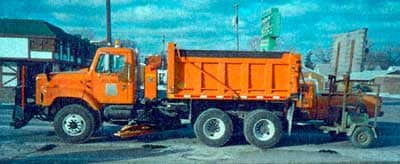 |
|
Figure 2. Backup Truck
|
The County Department of Public Services, Roads Division (county) for whom the decedent worked had responsibility for maintenance and repair of county facilities, roadways and infrastructure. The county had been incorporated for approximately 50 years. It was divided into 6 districts for road maintenance purposes. The manager of the district assigned the road crews.
The county had a joint labor/management health and safety committee that met at least monthly. The county had a similar fatality three years before this fatality. At that time, it developed a written training program for the cold patch road repair task, but it was not implemented. At the time of the incident the foreman provided on-the-job (OJT) cold patch training, but it is not known if the decedent received the training because no records were kept of OJT. The county had also indicated that they would test and install proximity sensing devices after the previous fatality, but none had been installed on any of the trucks in use.
The decedent was a member of the local municipal union. Each local union had a safety representative. The safety representative attended periodic labor/management safety meetings where common issues were discussed and the information was disseminated to the membership. The decedent had been hired by the county as a part time seasonal service worker five months before he was hired as a full time road maintenance worker. He worked full time as a road maintenance worker for three months before the incident. The driver of the backup vehicle that struck him had a valid Commercial Drivers License (CDL) as required of all county drivers. The CDL training was done in-house with appropriate materials and demonstrations. The drivers took the state exam to obtain their license.
The MIOSHA Construction Safety and Health Division investigation resulted in one Serious and two Willful/Serious violations being issued to the company:
- Serious: GENERAL RULES, PART 1 Rule 114(1). The employer failed to maintain an adequate accident prevention program. The material in the employer’s manual was outdated and ineffective.
- Willful/Serious: GENERAL RULES, PART 1, Rule 408.40114(2)(b). The employer failed to ensure that equipment operators had training that would allow them to recognize the exposure hazards associated with the backup vehicle operating too close to the lead vehicle.
- Willful/Serious: GENERAL RULES, PART 1, Rule 408.40114(2)(d). The employer failed to provide adequate training to pothole repair employees to recognize and minimize the hazards associated with doing pothole repair in the public right-of-ways.
Abatement
The county was required to implement the following abatement measures:
- Develop and implement an effective training program for cold patch repair crews and a tracking system for scheduling and documentation;
- Train all road repair employees including summer-hired seasonal workers as well as fulltime workers in safe procedures for cold patch repair in a timely manner;
- Use an observer/spotter (5th person added to crew) for cold patch repair to oversee operation and ensure appropriate procedures are being adhered to. This spotter is stationed between the trucks in the same area as the cold patch applier;
- Install proximity alarms on road repair vehicles and continue to test devices to find the most effective one for the conditions under which it will be used.
Investigation
On the day of the incident the weather conditions were clear and cold. The decedent was one of a crew of four workers applying cold patch to potholes. All members of the crew wear a high-visibility vest with 1-1/4 inch reflective tape, which they put on before they leave the yard and wear all day. Thecrew began work at 7:00 a.m. The incident occurred at 9:30 a.m. One worker drove the lead dump truck with the cold patch; one drove the backup truck pulling the flasher board with the arrow warning drivers to stay back; one cold patch applier was inside the lead truck; and the decedent was applying cold patch to potholes. The workers applying the cold patch would occasionally trade off to let one ride because of the bitter cold weather. It is not known whether there had been a worker switch.
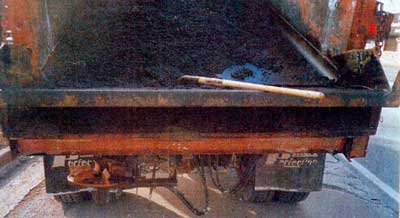 |
|
Figure 3. Cold patch in lead truck
|
The tailgate of the lead truck was lowered and the bed was inclined so the workers could access the cold patch repair material (Figure 3). The trucks were proceeding at the normal pace, approximately three miles per hour. The backup vehicle was expected to stay approximately 50 feet behind the lead vehicle except in intersections where it pulled up closer to prevent cars from slipping between the two work vehicles. The vehicles had just passed an intersection moving southbound, so the backup vehicle was somewhat closer than it would normally have been. The road had six lanes (three northbound and three southbound) plus a median and a left turn lane. The speed limit was 35 miles per hour. The vehicles were in the left of the three southbound lanes next to a left turn lane (Diagram 1).
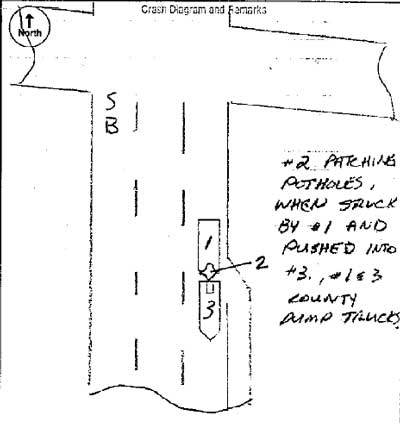 |
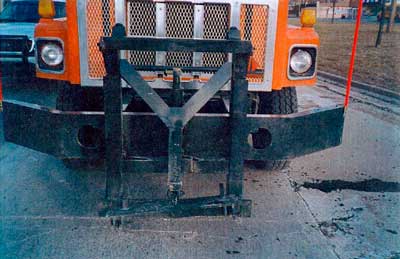 |
|
Figure 4. Front of backup vehicle
|
The decedent was walking between the two vehicles filling pot holes with cold patch he shoveled from the back of the lead truck. The backup vehicle (Figure 4) struck the decedent, pushing him into the lead truck for a moment. The driver of the lead truck indicated he was waiting for the decedent to give him a signal to move forward when he felt a small bump. He looked back and saw the decedent on the ground in the left turn lane. Both he and the coworker exited the vehicle to assist the decedent.
The driver of the backup truck stated to the responding police officers when they arrived on the scene that he had been watching a dark colored sport utility vehicle coming up behind the backup truck at a high rate of speed in his rear view mirrors. When he looked forward, he saw the decedent walk off to the side of the road and lie down. A witness to the incident stated that he had been stopped behind the patching crew for several minutes waiting to enter the left turn lane the crew was working adjacent to with his left turn signal activated. He was driving a blue work van. He said he observed the backup vehicle move forward several times. He observed it back up slightly and saw the decedent collapse in the left turn lane. He called 911.
The first police officer to arrive spoke to the decedent who was lying in the roadway in pain. The decedent indicated he was at the rear of the cold patch truck in order to fill his shovel with cold patch when he was struck in the back by the backup vehicle and pinned momentarily between the two trucks. The decedent was placed on a backboard and attended to by fire department rescue and ambulance paramedics. He complained of back and abdomen pain and was transported to the hospital where he was admitted for care and observation. Responding police took incident scene photographs, but did not take any incident scene measurements.
Two days after the incident, the decedent was being discharged from the hospital. He was in the corridor waiting to be released when he told a nurse that he was not feeling well. She told him to go back to bed, but before he could do so, he collapsed and died.
The driver of the backup vehicle was charged with negligent homicide. The charge was subsequently changed to reckless driving, and he was given a one-year probation during which time he was enrolled in a counseling program.
Back to Top
Cause of Death
The cause of death as listed on the medical examiner’s report was acute peritonitis due to mesenteric tear due to crush injury to the abdomen. Toxicology tests indicated the presence of drugs consistent with hospital medication.
Back to Top
Recommendations/Discussion
The employer should develop and provide to periodic training that ensures that employees recognize the hazards associated with their work and the consequences of becoming complacent regarding those hazards.
A similar incident that resulted in a fatality occurred in this county three years before this incident. After the first fatality the county developed a training program addressing the cold patch work procedures, but it was never effectively implemented. It reverted to on-the-job training (OJT) given by the job foreman. The training developed following the second fatal incident is included as Appendix A.
Training that impacts worker attitudes and behaviors is the most difficult type of training to accomplish. Just because a worker knows how to safely perform a task does not mean a worker will perform that task safely 100 percent of the time. The importance of remaining focused on the task at hand at all times should be emphasized. Including in the training the consequences (two fatalities in the case of this county) of not performing the work safely may provide an incentive powerful enough to affect the attitudes and behaviors of the road repair crew workers.
The employer should install after market devices (i.e., camera, radar, and sonar) on construction vehicles and equipment to help monitor the presence of workers on foot in blind areas.
At the time of the first fatality three years before this fatality, the county had indicated it would install and test proximity sensing/warning devices on its maintenance vehicles but had not done so. Following the second fatality the county requested and received proposals from collision warning system vendors. The county is using a radar-based warning system on a trial basis. This system was installed on several vehicles to detect and alarm the presence of personnel at a minimum of 15 feet in front of the backup vehicle in order to avoid any type of vehicular crush/pinch point incident. Several difficulties have been encountered implementing the system, but it seems reasonable to assume that they can be overcome with attention and follow-through on the part of the manufacturer and the county.
Emerging technology, such as sensor-based systems, rear-view cameras, and radio frequency identification (RFID) tags and tag readers are becoming available for construction equipment, though testing and demonstration at construction projects are still needed (1, 2, 3). Collisions between construction vehicles, equipment and workers have been attributed, in part, to limited visibility around the equipment. As new or existing monitoring technologies are proven to be effective on work sites, equipment manufacturers should offer these systems on new equipment.
Employers should ensure that safe work procedures are in place for the use of mobile construction vehicles, a spotter is designated to direct movement of these vehicles, and drivers are in communication with workers on foot.
Safe work procedures should be developed and implemented for each roadway construction job. In this case, there was not a designated spotter. Protocols should include an assigned spotter and instruction that vehicle movement will not begin without an understandable signal from the spotter that it is safe to do so (3). In addition, operators of construction vehicles and equipment must come to a complete stop if contact with a spotter is lost, and operations should not resume until contact is re-established. All equipment operators and truck drivers, while in the construction site, should be aware of who the spotters are, and the established safe work protocol. To assist with making themselves visible to the operators, all workers on foot (e.g., spotters, flaggers) should be required to wear a high visibility safety garment.
References
MIOSHA standardsexternal icon cited in this report may be found at and downloaded from the MIOSHA, Michigan Department of Labor and Economic Growth (DLEG) web site at: http://www.michigan.gov/mioshastandards. MIOSHA standards are available for a fee by writing to: Michigan Department of Labor and Economic Growth, MIOSHA Standards Section, P.O. Box 30643, Lansing, Michigan 48909-8143 or calling (517) 322-1845.
- Ruff, Todd M.[2003]. Evaluation of Systems to Monitor Blind Areas Behind Trucks Used in Road Construction and Maintenance – Phase 1. NIOSH Report of Investigations 9660 (DHHS Publication No. 2003-113), 16 pp.
- Ruff, Todd M. [2001]. Monitoring Blind Spots – A Major Concern for Haul Trucks. Engineering and Mining Journal, V.202, N.12, December 2001, p.17-26.
- Pratt SG, Fosbroke DE, Marsh SM [2001]. Building Safer Highway Work Zones: Measures to Prevent Worker Injuries from Vehicles and Equipment Cincinnati, OH: U.S. Department of Health and Human Services, Centers for Disease Control and Prevention, National Institute for Occupational Safety and Health (Pub. No. 2001-128).
- Accident Prevention Manual for Business & Industry, Engineering and Technology, 11th Edition, National Safety Council, Chicago, 1997.
- MIFACE INVESTIGATION # 06MI096: Ground Man For Milling Operation Dies When Struck By Dump Truck Backing Into Work Zone.pdf iconexternal icon Internet Address: www.oem.msu.edu.
Appendix
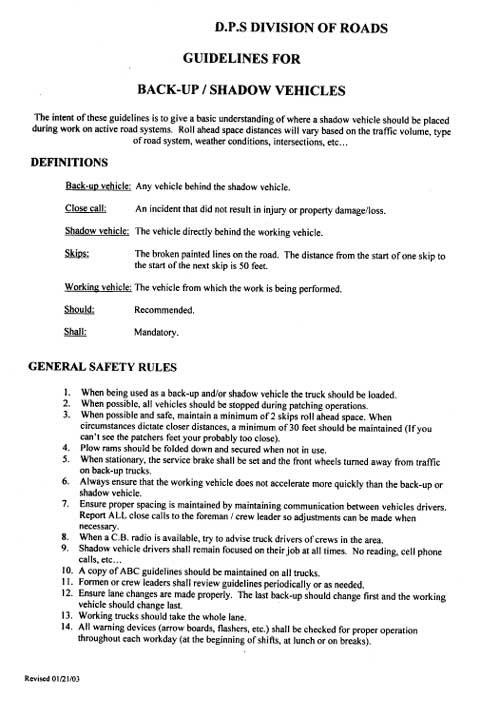 |
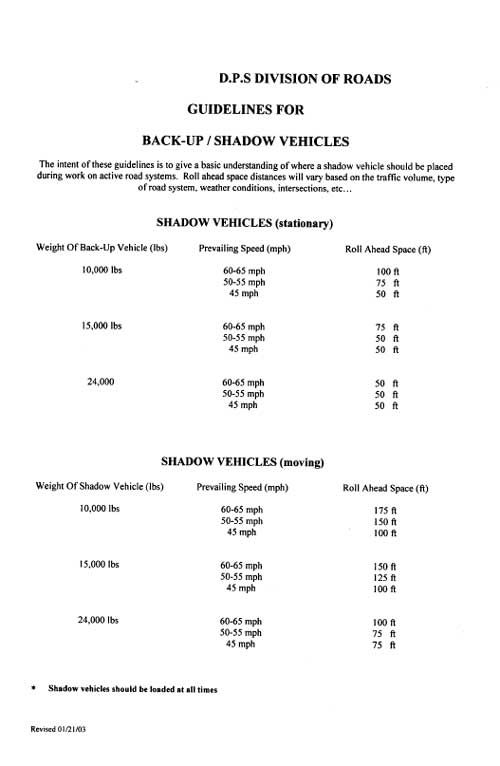 |
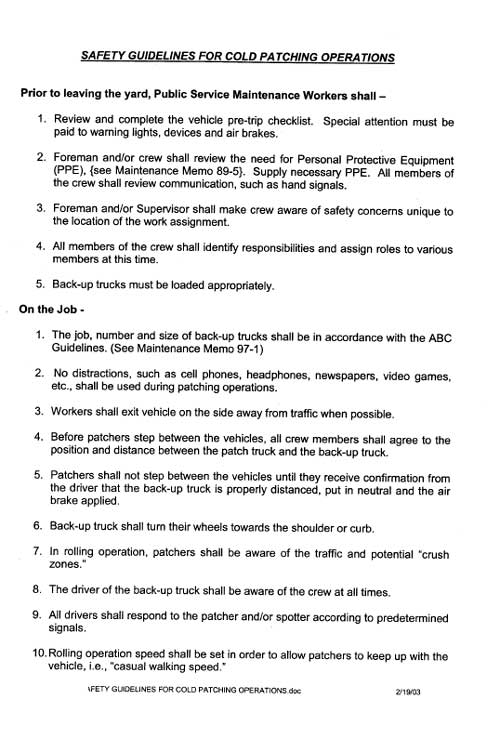 |
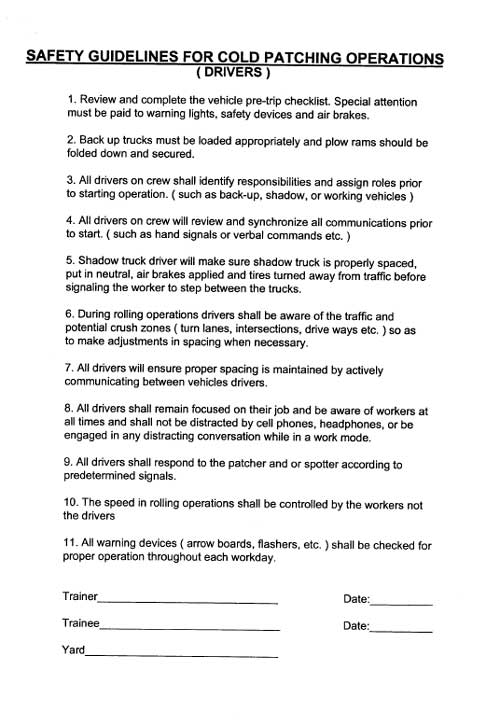 |
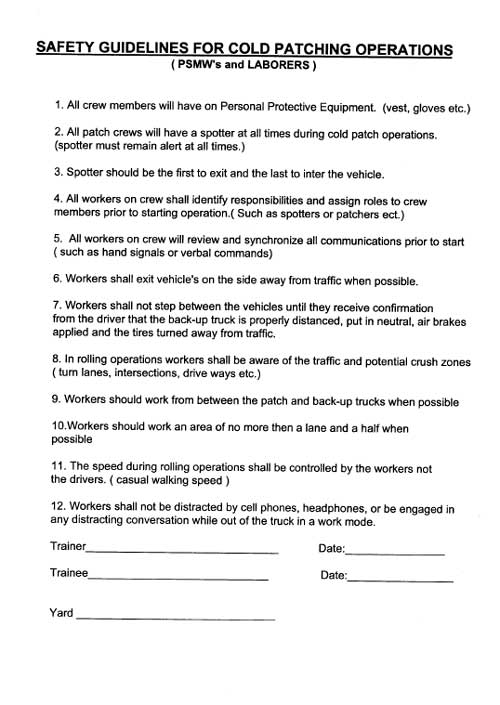 |
Michigan FACE Program
MIFACE (Michigan Fatality Assessment and Control Evaluation), Michigan State University (MSU) Occupational & Environmental Medicineexternal icon, 117 West Fee Hall, East Lansing, Michigan 48824-1315. Internet Address: http://www.oem.msu.edu/MiFACE_Program.aspx. This information is for educational purposes only. This MIFACE report becomes public property upon publication and may be printed verbatim with credit to MSU. Reprinting cannot be used to endorse or advertise a commercial product or company. All rights reserved. MSU is an affirmative-action, equal opportunity employer. 09/12/2007 (Link updated 8/5/2009)
MIFACE Investigation Report # 03MI005 Evaluationpdf iconexternal icon (see page 8 of report)
To contact Michigan State FACE program personnel regarding State-based FACE reports, please use information listed on the Contact Sheet on the NIOSH FACE web site Please contact In-house FACE program personnel regarding In-house FACE reports and to gain assistance when State-FACE program personnel cannot be reached.
